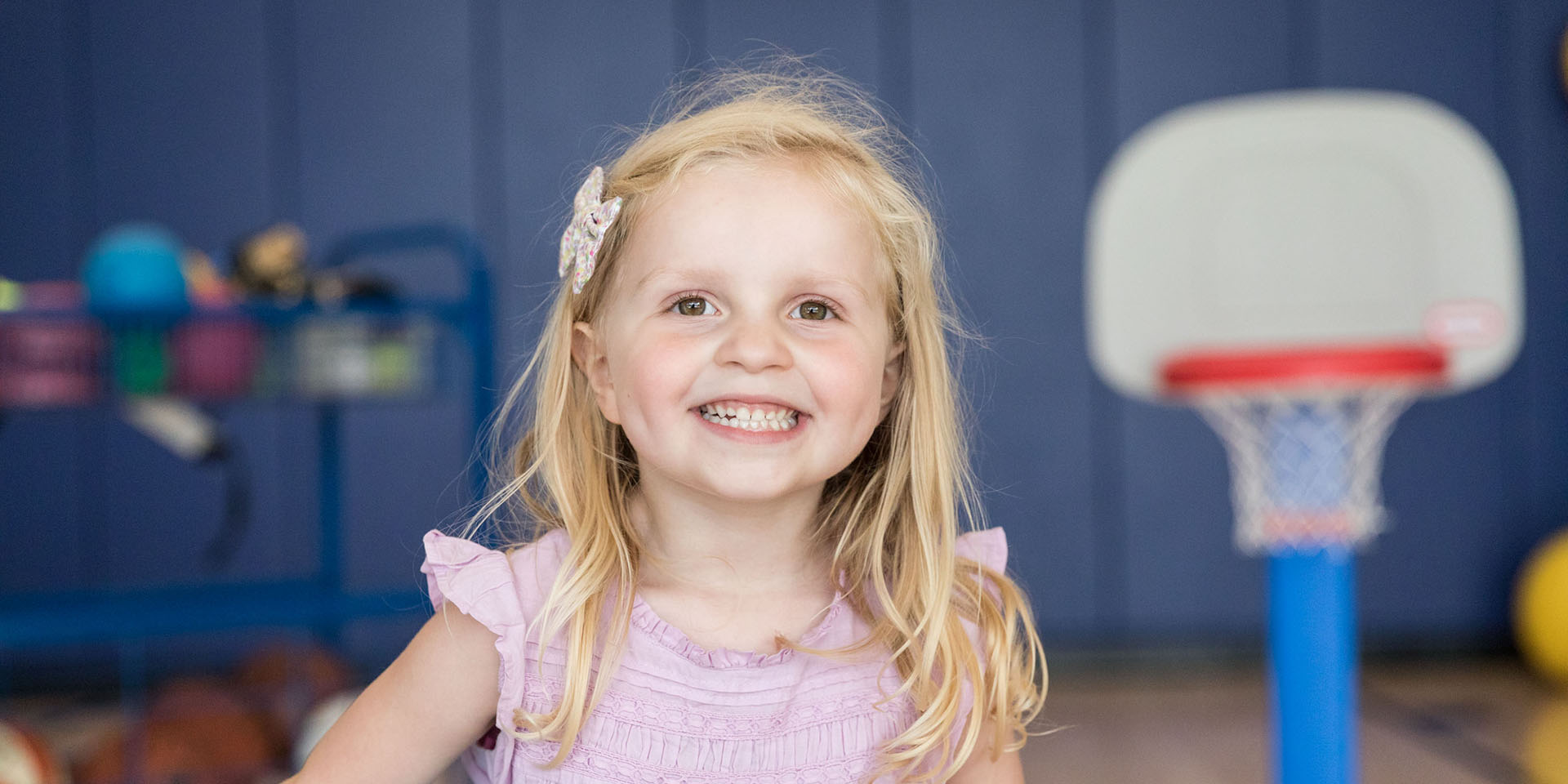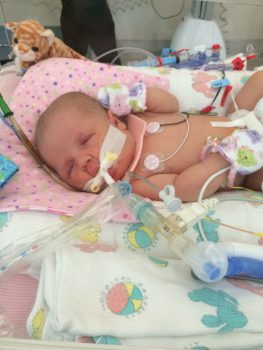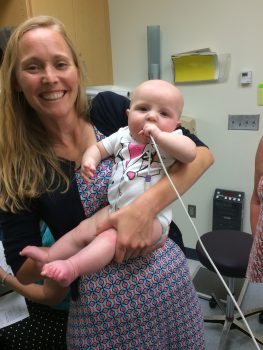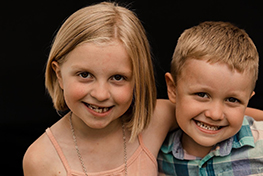
Meet Summer
After Life-Saving Surgery, Summer Overcomes the Odds
 When Cassie Fannin and her husband arrived at her 19-week ultrasound, the newly married couple was excited to learn more about their child. However, the first-time parents’ joy quickly turned to uncertainty when the ultrasound showed their baby’s stomach in her chest due to a life-threatening condition.
When Cassie Fannin and her husband arrived at her 19-week ultrasound, the newly married couple was excited to learn more about their child. However, the first-time parents’ joy quickly turned to uncertainty when the ultrasound showed their baby’s stomach in her chest due to a life-threatening condition.
Fannin learned that her daughter, Summer, would be born with a congenital diaphragmatic hernia (CDH). Summer had a hole in the left side of her diaphragm that allowed her stomach, intestines and a portion of her liver to slip through into her chest cavity. This prevented her left lung from developing normally.
“To say it was a shock is an understatement,” said Fannin. “We went from being ecstatic about finding out we were having a girl to absolutely devastated in a matter of seconds. I left that day a completely different person. My sadness slowly turned into anger and resentment as I thought, ‘Why us? Why our baby?’”
Doctors referred the family to Seattle Children’s Fetal Care and Treatment Center since Fannin’s baby would need surgery after birth, if she survived. The couple met Dr. Kimberly Riehle, an attending surgeon at Seattle Children’s, when Fannin was about 22 weeks along.
“My husband and I were completely lost and overwhelmed,” said Fannin. “Dr. Riehle helped ease our troubled minds during a really uncertain time. My feelings of bitterness and sorrow slowly started to melt away as I came to terms with the diagnosis and the realization that we were no different than anyone else getting a life-changing diagnosis, and I just focused on my excitement to meet her.”
Making a connection
 Before the diagnosis, the Fannins had set aside the name Summer for their unborn daughter, with a little uncertainty due to her pending winter birthday. After the diagnosis, Fannin’s sister gave her a piece of art with a quote by Albert Camus that rang true: “In the midst of winter, I found there was, within me, an invincible summer.” Their name uncertainty was gone after reading the quote.
Before the diagnosis, the Fannins had set aside the name Summer for their unborn daughter, with a little uncertainty due to her pending winter birthday. After the diagnosis, Fannin’s sister gave her a piece of art with a quote by Albert Camus that rang true: “In the midst of winter, I found there was, within me, an invincible summer.” Their name uncertainty was gone after reading the quote.
“My invincible daughter would be born in the winter with the odds stacked against her,” said Fannin.
Riehle recommended that the family give birth at the University of Washington Medical Center to be close to Seattle Children’s, where Summer would need to go after birth for neonatal intensive care and surgery.
“My husband and I had only gotten married earlier in the year and in many ways, I still felt like a kid myself and I definitely wasn’t sure what I was doing,” said Fannin. “Dr. Riehle was one of the first people to make me feel like a mom. She made me feel confident in my instincts, strong in my convictions, and reminded me that this is my child and I could absolutely handle anything for Summer.”
Riehle said that prenatal appointments are a chance for providers to bond with families and explain the diagnosis.
“Our prenatal clinic is a great opportunity to make a connection to a family and help them prepare,” said Riehle, surgical lead for the Prenatal Diagnosis and Treatment Program. “So many emotions go into having even a healthy baby, and throwing a CDH diagnosis on top of it all is really overwhelming. We educate the parents about what the diagnosis will mean for the baby, make plans for the remainder of the pregnancy and delivery and do everything we can to help them to prepare to have a baby who will need surgery and will be critically ill in the neonatal intensive care unit (NICU).”
Two surgeries and a familiar face
 Summer was born at 39 weeks on Jan. 23, 2015. She was immediately taken away to be revived and intubated. Before Summer was transported to Seattle Children’s, Fannin was able to see her briefly.
Summer was born at 39 weeks on Jan. 23, 2015. She was immediately taken away to be revived and intubated. Before Summer was transported to Seattle Children’s, Fannin was able to see her briefly.
“I was finally able to touch her and she opened her eyes and wrapped her little fingers around mine,” said Fannin. “We knew each other immediately and she was absolutely perfect.”
Fannin joined her husband and daughter at the hospital after recovering.
After her birth, Summer had pulmonary hypertension and difficulty maintaining normal oxygen and carbon dioxide levels, which Fannin and her husband expected. Once stable, Summer had her surgery to repair her CDH. Riehle brought Summer’s stomach, intestines and liver into her abdomen. She then covered the hole in Summer’s diaphragm with a synthetic patch to keep the two body cavities separate.
Summer recovered over the next two weeks with the help of a ventilator, oscillator and high flow oxygen. At 4 weeks old, Summer moved out of the NICU.
“It was an exciting time for us because we finally had the opportunity to stay with our baby, sleep in the room with her and take care of her more than we had ever before,” said Fannin.
Soon, Summer was weaned off of oxygen assistance and went home only 6 weeks after her birth.
Through the next several months, Summer’s care continued. She had another surgery to have some scar tissue removed that was causing a bowel obstruction and where she received a gastrostomy tube to maintain nutrition since she was having trouble eating enough by mouth. When she was 2 and a half years old, the gastrostomy tube was removed and she has since been able to eat on her own.
“Babies can really make it through a lot,” said Riehle. “CDH babies are some of the sickest babies in the hospital, but once they and their families make it through the difficult neonatal period, they should have a good life. We expect that these babies will just get better and better with time.”
Not defined by her diagnosis
 Today, Summer is an active, energetic and loving 9-year-old. She’s a gymnast and an artist and enjoys skating and softball. Summer loves her family, especially her little brother and their two kitties. “She still has lots of appointments at Seattle Children’s,” says Cassie, Summer’s mom. “But most people she meets have no idea she has any limitations. She is brave and determined and an absolute light.”
Today, Summer is an active, energetic and loving 9-year-old. She’s a gymnast and an artist and enjoys skating and softball. Summer loves her family, especially her little brother and their two kitties. “She still has lots of appointments at Seattle Children’s,” says Cassie, Summer’s mom. “But most people she meets have no idea she has any limitations. She is brave and determined and an absolute light.”
Fannin hopes that other families who find themselves in an unexpected medical situation like what she experienced remember these words: “You are enough for your child, you didn’t do anything wrong, and you are not alone. There will be some heartache, but there will also be so much joy and you are strong enough to get through this as a family.”
Looking back at her family’s journey, she also is grateful to the caregivers who were there along the way.
“We have met and interacted with some of the best people we never wanted to meet,” said Fannin. “There is so much patience and grace at Seattle Children’s. Not only did my family start inside those walls, I also learned how to be a mom with the help of nurses, doctors and countless medical staff. I will forever be thankful.”
